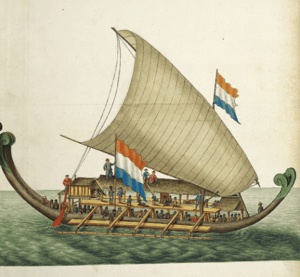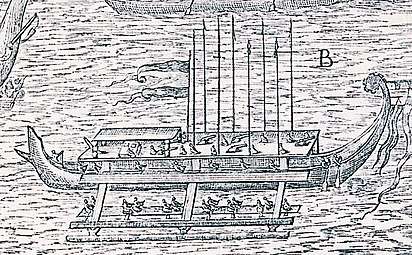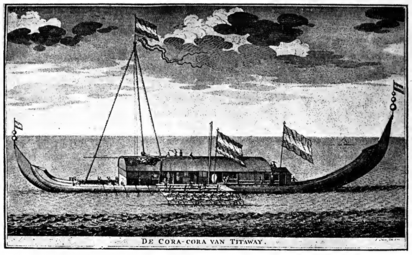Kora kora

A kora-kora or kora kora or coracora is a traditional canoe from the Maluku (Moluccas) Islands, Indonesia. It is approximately ten metres long and very narrow,[1] quite open, very low, and weighs about four tons.[2] It had outriggers of bamboo about five feet off each side, which supported a bamboo platform extending the whole length of the vessel.[2] On the extreme outside of this sit the twenty rowers (overall it needs 40 paddlers),[2][3] while within was a convenient passage fore and aft. The middle portion of the boat is covered with a thatch-house, in which baggage and passengers are stowed. The gunwale is not more than a foot above water, and from the great top and side weight.[2] The shape of the boat itself is similar to a Chinese Dragon Boat.
According to Robert Dick-Read, every leader in the Maluku region has its own ship, the leader's status depends on the number of slaves, who come from a distant island, which he captures and collects. Each ship is rowed by 300 rowers, supported by men armed with spears, blowgun, arrows, and swords in a higher fighting platform called 'balai'. The vessel has two steering wheels on the side, a tall pole in the stern and bow that decorated with ribbons. In the past, these poles were adorned with conquered enemy heads.[4]
This boat is used for both trade and warfare. Bigger kora-koras were used as war vessels during the war with the Dutch in the Banda Islands during the 17th century. Since ancient times the steerer and paddlers of these traditional Moluccan rowing boats yelled 'Mena Muria', to synchronise their strokes during off shore expeditions. This literally means 'Front - Back', but is also translated to 'I go - We follow' or 'One for all - All for One'.
Some of the bigger rowing boats could have over 100 rowers and when used on the maritime war path, during for instance a so-called 'hongitocht' (war expeditions for the Dutch East India Company during the 17th century), the approach of the 'kora kora' struck fear in the hearts of the villagers from the attacked coastal village.[5]
Etymology
The name comes from the Spanish and Portuguese, derived from the Arabic qorqora, the plural of qarâqir.[6]
Gallery
 Large kora-kora with 6 cannons
Large kora-kora with 6 cannons_en_rorehe_TMnr_10010571.jpg) A kora-kora from Halmahera, Maluku Islands (c. 1920) with a tanja sail
A kora-kora from Halmahera, Maluku Islands (c. 1920) with a tanja sail.png) 1863 illustration of a kora-kora warship in Maluku
1863 illustration of a kora-kora warship in Maluku A 1726 depiction of a large kora-kora from Halmahera
A 1726 depiction of a large kora-kora from Halmahera
See also
- Karakoa, similar warships from the Philippines
- Garay (ship)
- Borobudur ship
- Kakap
References
- ↑ (in Dutch) National archive
- ↑ Spice Islands voyage
- ↑ Dick-Read, Robert (2008). Penjelajah Bahari: pengaruh peradaban Nusantara di Afrika. PT Mizan Publika.
- ↑ Clive Moore, New Guinea: Crossing Boundaries and History, University of Hawai'i Press, Honolulu, pp. 97-98
- ↑ Instituut voor Nederlandse Geschiedenis - VOC-Glossarium bezocht 5 juli 2008